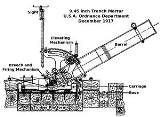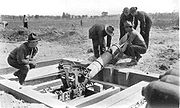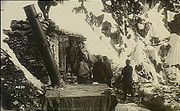
240 mm Trench Mortar
Encyclopedia
The 240 mm Trench Mortar, or Mortier de 240 mm, was a large calibre mortar
of World War I
. An original French design, it was developed by Batignolles Company of Paris and introduced in 1915.
In action, a heavy timber platform was constructed embedded in the ground, on which the mortar base was immovably secured. The mortar carriage sat on the base and could traverse. The mortar barrel and breech were mounted on the carriage which provided elevation
.
They were used in the "siege warfare" on the Western Front
to destroy enemy strongpoints, bunkers and similar "hard" targets which were invulnerable to lighter mortars and field guns. The US Army handbook described it : "... the use for which it is primarily adapted is in the bombardment of strongly protected targets—dwellings, covered shelters, command posts, entrances to galleries, etc—or in the destruction of sectors of trenches, salients and the like.". Their effectiveness decreased late in the war as German policy changed to a lightly held frontline, hence decreasing available targets, and they became redundant when the war of movement resumed in mid-1918.
Its first major use was in the Champagne offensive
of September 25, 1915.
This was followed later by the Mortier de 240 mm LT ("long de tranchée") which was a long barreled version with improved firing arrangement and breech-loaded charge which fired a 179 lb (81.2 kg) bomb 2265 yards (2,071.1 m), using a propellant charge of 2 lb (0.90718474 kg). This appears to be the bomb configuration adopted by USA.
French estimates were 80 bombs needed to destroy a strong shelter with a roof of concrete or rails and concrete.
 David Lupton's Sons Co manufactured the weapon in the United States during World War I.
David Lupton's Sons Co manufactured the weapon in the United States during World War I.
The US version appears to have been a direct copy of the Mortier de 240 mm LT, i.e. with longer barrel and propellant charge loaded into the breech via a brass cartridge case, was also produced late in the war but it is doubtful whether any were actually used in combat. The December 1917 manual describes the weapon as "9.45 inch" but makes clear it is the French 240 mm they are describing that the US has adopted. The bomb is described as weighing 180 lb (81.6 kg), with an explosive charge of 90 lb (40.8 kg) and range from 660 to 2500 yards (2,286 m).
The March 1918 manual describes the Bomb, Model 1916, Type T, weight 183 lb (83 kg), explosive 93 lb (42.2 kg), length 1.02 m (40 in). Barrel and breech weighing 690 lb (313 kg), carriage 448 lb (203.2 kg), base 764 lb (346.5 kg), timber platform 5720 lb (2,594.5 kg). Propellant charges of 800 grams Ballistite
+ 15 grams F-3 black powder for 750–1400 meters, and 1250 grams Ballistite
+ 15 grams F-3 for 1100–2200 meters. This figure agrees with the charge quoted for the mortar in French use for maximum range.
"Separate loading ammunition" was used i.e. the mortar bomb was a separate unit from the propellant cartridge case, which was flanged, brass, 9.776 inches long x 6.67 inches (169.4 mm) diameter (248.3 by 169.4 mm). The bomb was loaded into the barrel muzzle. The cartridge containing propellant charge appropriate for the required range was loaded into the breech, similar to a howitzer
.
The mortar was fired by pulling a lanyard, which triggered a primer in the base of the cartridge case and ignited the propellant charge in the cartridge. The cartridge cases could be reused after cleaning and replacing the primer.
 Italy used both the French CT and LT versions and produced their own long barrel version.
Italy used both the French CT and LT versions and produced their own long barrel version.
during World War I
based on examples captured from Italy, although the Austrians had problems recreating the original powder mixture and their shells suffered from large dispersions.
US 240 mm
The US manuals for the mortar appear to be based on French manuals e.g. the soldiers depicted are in French uniform.
German 240 mm
Mortar (weapon)
A mortar is an indirect fire weapon that fires explosive projectiles known as bombs at low velocities, short ranges, and high-arcing ballistic trajectories. It is typically muzzle-loading and has a barrel length less than 15 times its caliber....
of World War I
World War I
World War I , which was predominantly called the World War or the Great War from its occurrence until 1939, and the First World War or World War I thereafter, was a major war centred in Europe that began on 28 July 1914 and lasted until 11 November 1918...
. An original French design, it was developed by Batignolles Company of Paris and introduced in 1915.
Service
The weapon was dismantled for transport, requiring four carts for the barrel, base, carriage and ammunition.In action, a heavy timber platform was constructed embedded in the ground, on which the mortar base was immovably secured. The mortar carriage sat on the base and could traverse. The mortar barrel and breech were mounted on the carriage which provided elevation
Elevation (ballistics)
In ballistics, the elevation is the angle between the horizontal plane and the direction of the barrel of a gun, mortar or heavy artillery. Originally, elevation was a linear measure of how high the gunners had to physically lift the muzzle of a gun up from the gun carriage to hit targets at a...
.
They were used in the "siege warfare" on the Western Front
Western Front (World War I)
Following the outbreak of World War I in 1914, the German Army opened the Western Front by first invading Luxembourg and Belgium, then gaining military control of important industrial regions in France. The tide of the advance was dramatically turned with the Battle of the Marne...
to destroy enemy strongpoints, bunkers and similar "hard" targets which were invulnerable to lighter mortars and field guns. The US Army handbook described it : "... the use for which it is primarily adapted is in the bombardment of strongly protected targets—dwellings, covered shelters, command posts, entrances to galleries, etc—or in the destruction of sectors of trenches, salients and the like.". Their effectiveness decreased late in the war as German policy changed to a lightly held frontline, hence decreasing available targets, and they became redundant when the war of movement resumed in mid-1918.
240 mm mortar in French use
The mortar was first introduced in 1915 as the Mortier de 240 mm CT ("court de tranchee"). It was a short barreled version which fired a 192 lb (87 kg) bomb for 1,125 yards (1,030 m), using a propellant charge of 1 lb 9 oz (710 g).Its first major use was in the Champagne offensive
Second Battle of Champagne
The Second Battle of Champagne was a French offensive against the invading German army beginning on 25 September 1915, part of World War I.-September 25 - October 6:...
of September 25, 1915.
This was followed later by the Mortier de 240 mm LT ("long de tranchée") which was a long barreled version with improved firing arrangement and breech-loaded charge which fired a 179 lb (81.2 kg) bomb 2265 yards (2,071.1 m), using a propellant charge of 2 lb (0.90718474 kg). This appears to be the bomb configuration adopted by USA.
French estimates were 80 bombs needed to destroy a strong shelter with a roof of concrete or rails and concrete.
240 mm mortar in US use

The US version appears to have been a direct copy of the Mortier de 240 mm LT, i.e. with longer barrel and propellant charge loaded into the breech via a brass cartridge case, was also produced late in the war but it is doubtful whether any were actually used in combat. The December 1917 manual describes the weapon as "9.45 inch" but makes clear it is the French 240 mm they are describing that the US has adopted. The bomb is described as weighing 180 lb (81.6 kg), with an explosive charge of 90 lb (40.8 kg) and range from 660 to 2500 yards (2,286 m).
The March 1918 manual describes the Bomb, Model 1916, Type T, weight 183 lb (83 kg), explosive 93 lb (42.2 kg), length 1.02 m (40 in). Barrel and breech weighing 690 lb (313 kg), carriage 448 lb (203.2 kg), base 764 lb (346.5 kg), timber platform 5720 lb (2,594.5 kg). Propellant charges of 800 grams Ballistite
Ballistite
Ballistite is a smokeless propellant made from two high explosives, nitrocellulose and nitroglycerine. It was developed and patented by Alfred Nobel in the late 19th century.-The development of smokeless powders:...
+ 15 grams F-3 black powder for 750–1400 meters, and 1250 grams Ballistite
Ballistite
Ballistite is a smokeless propellant made from two high explosives, nitrocellulose and nitroglycerine. It was developed and patented by Alfred Nobel in the late 19th century.-The development of smokeless powders:...
+ 15 grams F-3 for 1100–2200 meters. This figure agrees with the charge quoted for the mortar in French use for maximum range.
"Separate loading ammunition" was used i.e. the mortar bomb was a separate unit from the propellant cartridge case, which was flanged, brass, 9.776 inches long x 6.67 inches (169.4 mm) diameter (248.3 by 169.4 mm). The bomb was loaded into the barrel muzzle. The cartridge containing propellant charge appropriate for the required range was loaded into the breech, similar to a howitzer
Howitzer
A howitzer is a type of artillery piece characterized by a relatively short barrel and the use of comparatively small propellant charges to propel projectiles at relatively high trajectories, with a steep angle of descent...
.
The mortar was fired by pulling a lanyard, which triggered a primer in the base of the cartridge case and ignited the propellant charge in the cartridge. The cartridge cases could be reused after cleaning and replacing the primer.
240 mm Mortar in Italian Use

24 cm Minenwerfer M.16 reported in Austro-Hungarian use
Some 400 were copied and manufactured by BöhlerBöhler
Böhler, is an Austrian steel producer for special steel. Its multinational presence includes locations around the world, including the Americas, Europe, Asia and Africa....
during World War I
World War I
World War I , which was predominantly called the World War or the Great War from its occurrence until 1939, and the First World War or World War I thereafter, was a major war centred in Europe that began on 28 July 1914 and lasted until 11 November 1918...
based on examples captured from Italy, although the Austrians had problems recreating the original powder mixture and their shells suffered from large dispersions.
24 cm Heavy Flügelminenwerfer (finned smoothbore mortar) reported in German use
The US A.E.F. in France reported in March 1918 : "... a new pattern minenwerfer which was brought out in 1916 and looks very much like the French 240... uses a heavy bomb fitted with four vanes like the French 240 mm bombs. This bomb weighs 100 kg (220 lb) and contains 42 kg (93 lb) of explosive... ranges obtained vary from 490 to 1310 yards". The specifications appear similar to the early French 240 mm CT quoted above. It is unknown whether this was related to the French or Austrian Böhler versions.See also
- List of heavy mortars
- 25 cm schwere Minenwerfer25 cm schwere MinenwerferThe 25 cm schwerer Minenwerfer was a heavy trench mortar used by Germany in World War I. It was developed for use by engineer troops after the Siege of Port Arthur during the Russo-Japanese War of 1905 illustrated the usefulness of this class of weapon in destroying bunkers and fortifications...
German equivalent - 9.45 inch Heavy Mortar9.45 inch Heavy MortarThe ML 9.45 inch Heavy Trench Mortar, nicknamed the Flying Pig, was a large calibre mortar of World War I and the standard British heavy mortar from Autumn 1916 onwards. It was a modification of an original French design, the Mortier de 240 mm developed by Batignolles Company of Paris and...
British version
Surviving examples
- A French LT example is displayed in the open at Place de Longueval, France
Bernard Plumier : Link to his web page which has details and photograph Direct link to photograph - The Central Museum of The Royal Regiment of Canadian Artillery, Shilo Manitoba German 24 cm minenwerfer
External links
French 240 mm- Classic Encyclopedia. Trench Ordnance
- W L Ruffel, French Mortars of WW1
- List and pictures of WW1 surviving 240 LT mortars
US 240 mm
The US manuals for the mortar appear to be based on French manuals e.g. the soldiers depicted are in French uniform.
- "Handbook of the 9.45-inch trench mortar matériel" United States Ordnance Department. December 1917. Made available online by Combined Arms Research Library
- "Manual for trench artillery, United States Army (provisional). Part I, Trench Artillery.". Prepared at Headquarters AEF, France, March 1918. Made available online by Combined Arms Research Library
- "Manual for trench artillery, United States Army (provisional). Part IV, 240 mm. trench mortar." Prepared at Headquarters AEF France March 1918. Includes range tables. Made available online by Combined Arms Research Library
- "Provisional drill regulations for trench mortar batteries; 6" Newton and the 240mm. : chapters II, VI, and VIII". United States. War Dept, 1918. Made available online by Combined Arms Research Library
- "Handbook on trench mortar fuzes, Mark VII and Mark VII-E.". United States. War Dept, 1918. Made available online by Combined Arms Research Library
German 240 mm

